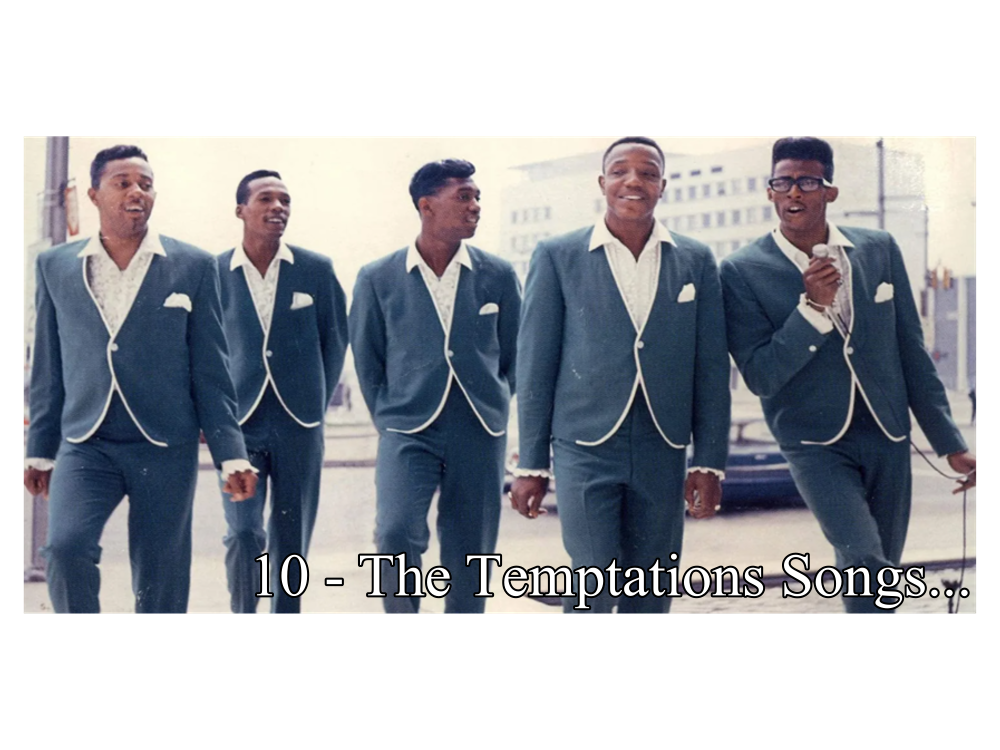(ThyBlackMan.com) There’s something about a Temptations record that hits you before the vocals even begin—the groove sets in, the bassline walks into your bones, and the harmony builds like a slow sunrise. From the moment that first Motown snare cracks, you know you’re in for something rich, layered, and deeply human. Whether it’s the velvety smooth falsetto of Eddie Kendricks or the gritty soul of David Ruffin, The Temptations brought not just vocals but full-on arrangements that told stories with every chord.
This isn’t just about nostalgia. These songs are masterclasses in production, vocal stacking, lyrical economy, and emotional delivery. With Norman Whitfield behind the boards and a group of singers whose chemistry could light a room on fire, The Temptations didn’t just make hits—they made timeless music. From lush ballads to psychedelic funk, these ten tracks reveal the full range of their artistry and evolution. If music is emotion set to rhythm, then The Temptations were fluent in every language.

1. “My Girl”
No list of The Temptations’ best songs would be complete without their signature hit, “My Girl.” Written and produced by Smokey Robinson and Ronald White, this 1964 classic remains one of the most iconic love songs in the Motown catalog. From the instantly recognizable opening bassline to David Ruffin’s warm, assured lead vocals, “My Girl” is a masterclass in emotional simplicity. It’s the kind of song that makes hearts flutter and feet tap without trying too hard.
The production is perfectly understated, allowing the melody and harmonies to take center stage. The use of strings and subtle horns adds a layer of sophistication that was rare in popular music at the time. But what truly elevates “My Girl” is its universality—a love song that feels personal and grand all at once. Ruffin’s tone conveys pride, joy, and certainty. It’s not over-the-top or flashy; it’s honest and radiant.
What’s also impressive is how this song became a defining moment not just for the group, but for Motown itself. “My Girl” shot to number one on the Billboard Hot 100 and cemented The Temptations as crossover stars. It exemplified the polished “Motown Sound,” which aimed to appeal across racial and geographic lines—and succeeded. This song became a model for future romantic pop ballads, influencing everyone from The Jackson 5 to contemporary R&B crooners.
Even today, “My Girl” is a go-to for weddings, anniversaries, and just about any moment that calls for sweetness and sincerity. It transcends generations, reminding listeners that sometimes the simplest sentiments are the most powerful. It is a musical time capsule, one that never loses its charm.
Why It’s a Must-Listen: A timeless declaration of love, impeccably performed and arranged—“My Girl” is soul perfection in under three minutes.
2. “Ain’t Too Proud to Beg”
With its pleading vocals and pounding rhythm, “Ain’t Too Proud to Beg” showcases a rawer, more urgent side of The Temptations. David Ruffin’s gravelly voice is front and center, filled with desperation and desire. Produced by Norman Whitfield, this track represented a shift toward a grittier, more emotionally intense sound—soul music with street corners and struggle baked into every note.
The song’s structure is built for maximum impact. The verses build tension, while the chorus explodes with Ruffin practically shouting, “Please don’t leave me, girl!” It’s not just a love song; it’s a cry for emotional survival. That level of vulnerability gave the track a realness that resonated deeply with fans. The combination of bold lyrics and Ruffin’s powerhouse delivery made it instantly relatable to anyone who’s ever loved too hard or held on too long.
The musical backdrop intensifies that emotional urgency. The driving rhythm section, sharp brass accents, and tambourine give the song a stomping momentum that keeps listeners moving. Yet, amid the danceable beat is the ache of a man unraveling—making it both a party track and a personal confession. It’s a fine balance that only a group like The Temptations could master.
Decades later, “Ain’t Too Proud to Beg” still resonates because it taps into a core truth of love: sometimes, it hurts. Sometimes you don’t want to let go, even when you should. And for that reason, it remains a crown jewel in the group’s emotionally rich catalog.
Why It’s a Must-Listen: A soulful plea that captures the pain and passion of love lost—equal parts groove and grit.
3. “Papa Was a Rollin’ Stone”
“Papa Was a Rollin’ Stone” is perhaps The Temptations’ most ambitious and cinematic work. Produced by Norman Whitfield and featuring a nearly 12-minute album version, the song is a sprawling, psychedelic soul epic. It marked a departure from their earlier love songs and ventured into socially conscious storytelling, fitting seamlessly into the turbulent atmosphere of the early 1970s.
The track opens with a haunting instrumental introduction—a nearly four-minute build of bass, strings, trumpet lines, and a wah-wah guitar that creates a sense of anxiety and anticipation. When the vocals finally arrive, they are haunting and accusatory. Dennis Edwards delivers the iconic first line, “It was the third of September / That day I’ll always remember,” with a mixture of pain, anger, and confusion. The song paints a portrait of a father who lived fast and left emotional wreckage behind—a rolling stone who sowed seeds but never stayed to watch them grow.
What’s remarkable is the layered composition. The musical arrangement is moody and ominous, allowing each vocal line to land like a chapter in a family’s trauma. Background vocals whisper in and out, almost like ghosts of the past. Whitfield’s production expands the song’s narrative, giving it room to breathe, unravel, and build to a thunderous climax. Each instrument tells part of the story.
Even now, “Papa Was a Rollin’ Stone” feels as groundbreaking as it did in 1972. It’s a soul song with the depth of a film, offering reflections on generational pain, masculinity, and abandonment. It’s not just a song you listen to—it’s a song you live through.
Why It’s a Must-Listen: A genre-defying masterpiece that tackles family and social issues with bold artistry—this is The Temptations at their most fearless.
4. “I Wish It Would Rain”
“I Wish It Would Rain” stands as one of the most heartfelt and emotionally devastating songs in The Temptations’ catalog. Penned by lyricist Rodger Penzabene, who tragically died by suicide shortly after its release, and composed by Norman Whitfield and Barrett Strong, the song captures the agony of heartbreak with poetic precision. David Ruffin’s lead vocal is nothing short of soul-shattering.
The brilliance of the song lies in its metaphor. Wanting the rain to hide one’s tears is a universally relatable sentiment, and the Temptations deliver it with such sincerity that it hits like a punch to the gut. Ruffin doesn’t perform the song—he confesses it. His vocal is vulnerable and raw, capturing that moment when the pain is too much to bear but must be expressed. You hear the ache in every syllable.
The orchestration is equally powerful. A lush string section swirls around a simple piano foundation, creating a sonic mood that matches the devastation in the lyrics. It’s restrained yet emotional, giving Ruffin all the space he needs to unravel in front of us. There’s no artifice here—just real, aching sorrow.
“I Wish It Would Rain” is the kind of song that reminds listeners it’s okay to feel broken. It doesn’t offer a resolution or a silver lining—it simply gives you the grace to grieve. In a music world often obsessed with triumph and resilience, this song remains a soft, sorrowful space to be human.
Why It’s a Must-Listen: A beautifully orchestrated ballad that captures emotional vulnerability with grace—soul music doesn’t get more honest than this.
5. “Just My Imagination (Running Away with Me)”
This dreamy ballad is one of The Temptations’ most beloved tracks, and for good reason. “Just My Imagination” is a gentle, wistful song about unrequited love and longing. Eddie Kendricks’ falsetto floats over the melody like a feather, making it one of the most ethereal songs in the group’s discography. The song’s entire framework is built around fantasy—loving from afar and creating a life in the mind that reality can’t match.
Lyrically, the song taps into the universal human tendency to escape into imagination. The protagonist dreams of a life with a woman who doesn’t even know he exists. “Soon we’ll be married and raise a family,” he sings with quiet joy, before admitting that none of it is real. That pain is subtle, but it’s there in every breath Kendricks takes. His falsetto is soft but devastating, perfectly matching the vulnerability of the subject matter.
Musically, it’s a return to the softer Motown sound, with lush string arrangements, gentle horn accents, and a slow, deliberate tempo that encourages introspection. The harmonies are warm and ghostly, giving the entire song a surreal, dreamlike atmosphere. It’s the musical equivalent of staring out a window on a rainy afternoon, lost in thoughts of what could be.
The song also holds historic weight as it marked a transitional moment for the group—Kendricks would soon depart, and the group would continue evolving its sound. “Just My Imagination” stands as a bittersweet swan song to their classic era, a final flourish of romance before the dawn of psychedelic soul and funk.
Why It’s a Must-Listen: A tender exploration of love and longing that still stirs the soul—this is introspective soul music at its finest.
6. “Ball of Confusion (That’s What the World Is Today)”
“Ball of Confusion” is a whirlwind of a song, capturing the chaotic energy of a world in flux. Released during a time of significant political and social upheaval, the song covers a staggering array of topics—Vietnam, segregation, politics, the economy, pollution, and drug abuse—without ever losing its musical footing. It’s a protest song for the ages, one that refuses to sugarcoat reality or offer neat solutions.
The instrumentation is aggressive and psychedelic, featuring a fast-paced rhythm, blaring horns, distorted guitars, and funky basslines. It’s a sonic departure from their earlier polished Motown hits, but proves that The Temptations were not afraid to evolve and comment on the world around them. Producer Norman Whitfield created a restless soundscape that mirrored the unrest of the time. The beat is relentless, mimicking the overwhelming pace of societal change and confusion.
Vocally, the track is a tour de force. Each member takes a verse or line, creating a sense of communal urgency—almost like a relay race of truths. Dennis Edwards, Paul Williams, and Melvin Franklin take turns delivering rapid-fire observations, giving the song a kaleidoscopic view of society. “Fear in the air, tension everywhere,” they sing, as if reporting live from the front lines of American life.
What’s powerful is that the song still resonates today. In a world plagued by political divides, economic uncertainty, and global crises, “Ball of Confusion” feels eerily prophetic. It’s more than a song—it’s a sonic time capsule that captures what it feels like to be alive in turbulent times.
Why It’s a Must-Listen: A bold, chaotic anthem that still resonates in today’s uncertain world—this is musical journalism at its most urgent and funk-infused.
7. “Cloud Nine”
“Cloud Nine” signaled a major shift for The Temptations as they fully embraced psychedelic soul and a new direction under producer Norman Whitfield. Winning the group their first Grammy Award, the track marked the beginning of their experimental era—a daring move that paid off both artistically and commercially.
The song is notable for its multi-lead vocals, a departure from the single-lead style of their earlier ballads. Dennis Edwards, the group’s new lead singer, brought a grittier tone to the forefront, but every member contributes vocally, weaving a rich tapestry of sound. Lyrically, the song touches on the harsh realities of urban poverty while implying escapism—possibly through drug use—making it one of Motown’s most controversial and socially relevant tracks.
Musically, “Cloud Nine” is bursting with energy. Fuzzy electric guitars, aggressive congas, echo effects, and rapid-fire drums come together to create a dense, hypnotic rhythm. It’s layered but not cluttered—a controlled chaos that reflects the disorientation of the era. The groove is infectious, making listeners want to dance even as the lyrics hint at a darker truth.
“Cloud Nine” helped Motown evolve, showing that socially aware music could still be radio-friendly. It bridged a gap between protest songs and commercial success. The Temptations weren’t just singing about love anymore—they were singing about life.
Why It’s a Must-Listen: A genre-shifting milestone that introduced a new era for the group, where funk met conscience and dance met depth.
8. “I Can’t Get Next to You”
With a funky intro and a full-throttle delivery, “I Can’t Get Next to You” is one of The Temptations’ most energetic and infectious tracks. Produced by Norman Whitfield, the song hit No. 1 on the Billboard Hot 100, and it’s easy to see why. It blends emotional frustration with a fast-paced, electric funk arrangement that grabs listeners by the collar and doesn’t let go.
Lyrically, the song uses hyperbole to make a point. The narrator can do just about anything—stop time, fly, make the seasons change—but he still can’t win the love of the one he desires. That clever contrast between grand power and emotional helplessness gives the track a dramatic edge. It’s humorous, tragic, and soulful all at once.
Each group member gets a turn on lead vocals, showcasing the immense vocal range and personality of the group. Dennis Edwards, Eddie Kendricks, Paul Williams, Melvin Franklin, and Otis Williams all shine. The constant vocal shifts keep the listener on their toes and give the song a sense of theatrical urgency. It’s more than just a track—it’s a performance.
The groove is unbeatable, driven by a tight rhythm section and bold brass accents. Whitfield’s production is both polished and wild, making it suitable for dancing or deep listening. Even decades later, it remains a staple in R&B playlists and old-school soul sets.
Why It’s a Must-Listen: A funk-infused declaration of romantic frustration, packed with vocal fireworks and irresistible rhythm.
9. “Since I Lost My Baby”
A tender ballad about lost love, “Since I Lost My Baby” is quintessential Motown heartbreak. Written by Smokey Robinson and Pete Moore, and sung with aching sincerity by Eddie Kendricks, this track showcases The Temptations’ ability to channel emotional vulnerability through beautiful melodies and subtle instrumentation.
The beauty of the song lies in its restraint. It doesn’t wallow in sorrow, but rather floats in it. The lyrics are poignant: “The sun is shining, there’s plenty of light / A new day is dawning, sunny and bright / But after I’ve been crying all night…” The contrast between a happy world and an aching heart hits hard. Life continues, but love has been lost—and everything feels out of sync.
Musically, it’s a lush and classic Motown production. The soft strings, gentle horns, and rolling percussion allow Kendricks’ voice to shine. His falsetto is flawless, capturing both fragility and control. The background vocals cushion his delivery, like friends trying to offer comfort in a moment of grief.
“Since I Lost My Baby” feels timeless because its message is so universal. Who hasn’t felt disconnected from the world after losing someone? Whether through breakup or death, the pain of absence is something everyone understands. This song gives that emotion a soundtrack, and it does so with grace.
Why It’s a Must-Listen: A soulful meditation on love’s absence, elevated by poetic lyrics, tender vocals, and classic Motown craftsmanship.
10. “Treat Her Like a Lady”
Released during the group’s later years, “Treat Her Like a Lady” is a testament to The Temptations’ adaptability and enduring relevance. Featuring the charismatic vocals of new lead singer Ali-Ollie Woodson, the track breathed new life into their sound and brought the group back into the pop and R&B spotlight during the mid-1980s.
The message is straightforward: respect and cherish the woman in your life. But the delivery is anything but basic. Woodson’s vocals are commanding and smooth, filled with energy, charisma, and just enough bravado to keep it cool. His presence on the track proved that The Temptations could evolve without compromising their vocal legacy.
Musically, the production leans into the ’80s aesthetic with polished synths, tight drum programming, and layered backing vocals that give it a slick and modern feel. Despite the updated sound, the song retains a sense of soul and warmth. It never feels robotic or overproduced—just refined and radio-ready.
Beyond its sonic appeal, “Treat Her Like a Lady” also served as a musical statement. In a decade often criticized for excess and shallow pop trends, The Temptations doubled down on values—respect, commitment, and integrity. And audiences responded. The song became a Top 10 R&B hit and helped reestablish the group as more than just legends of the past.
Why It’s a Must-Listen: A triumphant late-career hit that blends timeless values with modern production, proving The Temptations could thrive in any decade.
What makes The Temptations so unforgettable isn’t just their vocal talent—it’s how they used every musical element available to serve the soul of the song. The rhythm sections pulsed like heartbeats. The harmonies didn’t just accompany the lead—they built the atmosphere. And when the strings swelled or the guitars fuzzed out into wah-wah distortion, it was never gimmick—it was storytelling.
Even decades later, these songs still teach us what great music should sound like. They remind us that a perfectly placed harmony can say what words can’t, and that sometimes the quietest falsetto carries the heaviest truth. The Temptations weren’t just part of the Motown sound—they were one of its deepest, most musical voices. Play these tracks loud. Feel them fully. They were made for moments that matter.

















Leave a Reply